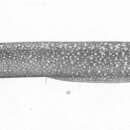pms
nòm ant ël fil


Muraena clepsydra, commonly known as the hourglass moray,[2] is a moray eel found in coral reefs from the Gulf of California to Peru, and the Galapagos Islands. It was described by Charles Henry Gilbert in 1898.[3] It dwells at a depth range of 0 to 25 metres (0 to 82 ft). Males can reach a maximum total length of 120 centimetres (47 in), but more commonly reach a TL of 60 centimetres (24 in).[3]
Due to its wide distribution, lack of known threats, and lack of observed population decline, the IUCN redlist currently lists M. clepsydra as Least Concern.[4]
Muraena clepsydra, commonly known as the hourglass moray, is a moray eel found in coral reefs from the Gulf of California to Peru, and the Galapagos Islands. It was described by Charles Henry Gilbert in 1898. It dwells at a depth range of 0 to 25 metres (0 to 82 ft). Males can reach a maximum total length of 120 centimetres (47 in), but more commonly reach a TL of 60 centimetres (24 in).
Due to its wide distribution, lack of known threats, and lack of observed population decline, the IUCN redlist currently lists M. clepsydra as Least Concern.